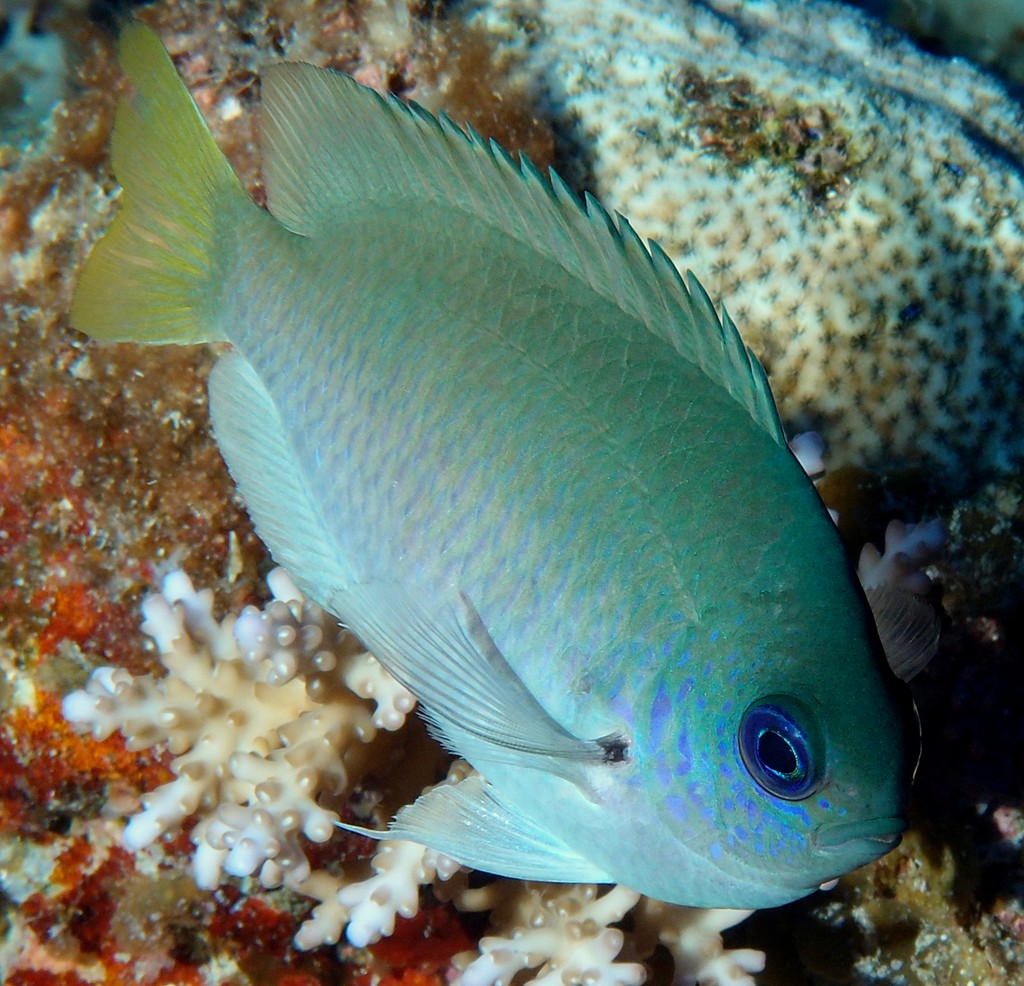POMACENTRUS REIDI - (FOWLER & BEAN, 1928)
Actinopterygii (Gigaclass) > Actinopteri (Class) > Teleostei (Subclass) > Blenniiformes (Order) > Pomacentridae (Family) > Pomacentrinae (Subfamily) > Pomacentrus (Genus)
Grey damsel, Reid's damsel, Reid's damselfish, 莱氏雀鲷,
Description
Dorsal spines (total): 13; Dorsal soft rays (total): 13-15; Anal spines: 2; Anal soft rays: 15-16. Relatively deep-bodied. Has a pale grey appearance in natural light. Blue spots and streaks on cheek and gill cover, pale blue streak on each body scale, small black spot on upper pectoral fin base. Juveniles slightly greenish. Max length: 9.0 cm TL. Depth range: 3 - 70 m.
Etymology
Pomacentrus: from Greek, poma, -atos = cover, operculum + from Greek, kentron = something with a sharp point: point, spike, spur, sting, quill, thorn. Referring to serrations and prickles along margins of opercular bones of Pomacentrus pavo.
Reidi: Henry W. Fowler Of the Academy of Natural Sciences of Philadelphia, and Barton A. Bean Of the United States National Museum take pleasure in dedicating this species to Mr. Earl D. Reid, aid in the Division of Fishes, United States National Museum.
Original description: Pomacentrus reidi Fowler & Bean, 1928 - Type locality: Tataan Island, Tawi Tawi Islands, Philippines.
Distribution
Indo-West Pacific: Eastern Indonesia, Philippines, Palau, Papua New Guinea to Vanuatu and New Caledonia, Australia.
Biology
Adults occur in steep outer reef slopes and deep lagoons to moderate depths. Generally solitary among large rubble pieces or the bases of large corals. Oviparous, distinct pairing during breeding. Eggs are demersal and adhere to the substrate. Males guard and aerate the eggs.
Grey damsel, Reid's damsel, Reid's damselfish, 莱氏雀鲷,
Description
Dorsal spines (total): 13; Dorsal soft rays (total): 13-15; Anal spines: 2; Anal soft rays: 15-16. Relatively deep-bodied. Has a pale grey appearance in natural light. Blue spots and streaks on cheek and gill cover, pale blue streak on each body scale, small black spot on upper pectoral fin base. Juveniles slightly greenish. Max length: 9.0 cm TL. Depth range: 3 - 70 m.
Etymology
Pomacentrus: from Greek, poma, -atos = cover, operculum + from Greek, kentron = something with a sharp point: point, spike, spur, sting, quill, thorn. Referring to serrations and prickles along margins of opercular bones of Pomacentrus pavo.
Reidi: Henry W. Fowler Of the Academy of Natural Sciences of Philadelphia, and Barton A. Bean Of the United States National Museum take pleasure in dedicating this species to Mr. Earl D. Reid, aid in the Division of Fishes, United States National Museum.
Original description: Pomacentrus reidi Fowler & Bean, 1928 - Type locality: Tataan Island, Tawi Tawi Islands, Philippines.
Distribution
Indo-West Pacific: Eastern Indonesia, Philippines, Palau, Papua New Guinea to Vanuatu and New Caledonia, Australia.
Biology
Adults occur in steep outer reef slopes and deep lagoons to moderate depths. Generally solitary among large rubble pieces or the bases of large corals. Oviparous, distinct pairing during breeding. Eggs are demersal and adhere to the substrate. Males guard and aerate the eggs.
